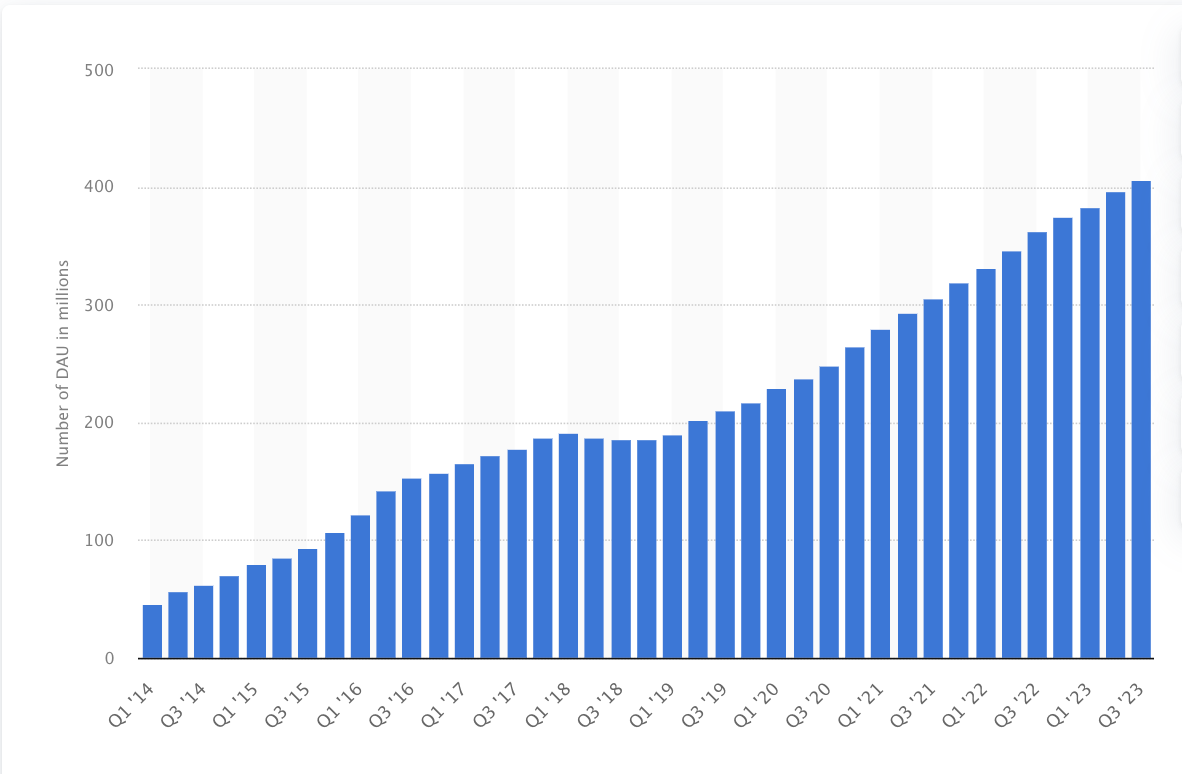SEO
How to Find Influencers for your Brand
As of 2021, the global influencer marketing market size is at $13.8 billion.
Are you ready to tap into this market and find the right influencers for your business?
In this blog post, we will walk you through a step-by-step guide on how to find the best influencers for your brand. We’ll cover everything from defining your goals to tracking the progress of your campaign.
Define your goals
The first step in finding the right influencers is defining your goals. Here are some questions to answer:
- Why do I want to work with influencers?
- What am I hoping to achieve?
- Do they align with the goals I have set up in my marketing plan?
- How much are we willing to spend for this collaboration?

Download: Quarterly Marketing Plan
By answering these questions, you ensure that it is crystal clear what your goals are and what role they play in your overall marketing plan, how the influencers can help you achieve them, and what you can offer in return for a fair collaboration.
For example, let’s say you’re in the health and fitness niche and your target audience are moms. Let’s answer the questions above.
- Why do I want to work with influencers?
The health and fitness niche is competitive and most of our competitors offer supplements or vegan alternatives. I offer a monthly subscription service where the customer will get a supply of vegan frozen meals every week. This can break into the market faster if I tap the right people to test and review them.
- What am I hoping to achieve?
Greater visibility and word-of-mouth marketing for my business.
- Do they align with the goals I have set up in my marketing plan?
Yes. I aim to sell at least 50 subscriptions for the first month to break even. Influencer marketing plays a significant role in achieving this goal.
- How much are we willing to spend for this collaboration?
$350 for a YouTube review with additional fees for Instagram and Tiktok posts depending on engagement and follower count.
Check industry pricing
Before you even start looking for influencers, you need to understand how the fees work. Fee structures for influencers may differ from country to country.
For example, a fee structure (or rate card) can look like this:

Or you can check industry rates and how they’re computed such as this guide by Get Hyped if you’re in the US.
Then edit your answer to the last question (How much are we willing to spend for this collaboration?) based on your findings.
This ensures that:
- You understand the type of influencer you can afford to collaborate with (nano, micro, etc.) so you can narrow down your research.
- Negotiations can be smoother because you already have an idea of how much you’re willing to spend and you understand how the fees work—haggling prices isn’t a good look for your brand because these influencers work hard to build and engage their audience base.
Research to find relevant influencers in your niche
Once you have defined your goals and checked the pricing, it’s time to find influencers.
Social media listening tools are a great way to find relevant influencers. These platforms allow you to track mentions of competitor brands so you can see who they’re working with. You can then look for influencers in that circle.
You can also use social media listening tools to track relevant hashtags. This is a great way to find influencers who are talking about topics that are important to your business.
Some of the most popular social media listening tools include Cloohawk and Buzzsumo.
Further reading: Social Listening vs Social Monitoring
As mentioned, you can find relevant influencers by identifying relevant hashtags. Hashtags are a great way to find people who are talking about specific topics.
Here’s a trick: find a famous influencer in your niche that’s out of your budget and check their hashtags. Then enter that hashtag into a free tool like Social Searcher to see who is using the same hashtag.

You can also opt to go on the platform you want to have the most visibility in and manually search the hashtags there. For example, you can go on Instagram and use #veganmom or #veganphilippines to narrow your search.
Use tools to find their contact details
There are various ways to contact influencers, and it usually is pretty easy to reach out to them.
More often than not, they are looking for opportunities to collaborate with brands, so their DMs are open, or their emails are in their bio or video description.
It’s a bit tedious to manually reach out to a bunch of influencers though especially if you’re trying to work with a lot of them.
NinjaOutreach
For that issue, check out NinjaOutreach.

NinjaOutreach is an outreach software used by digital marketing agencies, bloggers, and small businesses wanting to grow their online presence.
What’s great about this tool is that with a simple keyword search, you can find online influencers in your niche and see valuable information about them at the same time.
In this way, you can easily partner with influencers who are interested in promoting your brand to their audiences.
Although NinjaOutreach has a number of interesting features, we’re going to focus on two for this post:
Social media influencers finder
Interestingly, here’s what NinjaOutreach’s dashboard looks like when you log in:

On the left side of the dashboard, you will find Instagram, TikTok, and YouTube Influencers.
When you click on the Instagram Influencers tab, you can start searching for Instagram influencers by their username or keywords.
You can use the filter or sorting feature found on the left side of the dashboard if you want to narrow down your search.
Email Finder
Another NinjaOutreach’s cool feature is the email finder, where you can find someone’s email address by searching for a specific person and domain.
Use this feature if you’re looking to do any of the following:
- Guest post outreach
- Product review outreach
- Instagram influencer sponsorship
- Link building outreach
- Sponsored post outreach
- Expert roundup post outreach
- Podcast/Interview outreach
But what if the influencer you’re eyeing doesn’t have their contact information on their social media or website?
Here are other options you can look into:
Findthat.Email
Findthat.Email is a straightforward service. You enter an influencer’s name and their company or website and the email finder will give you their contact details. I can’t emphasize enough how easy it is to use.
The best part about this is the website allows you a few free sample searches on the main page.

This screenshot was taken directly from their homepage and the sample person I tried to find was Bill Gates of Microsoft.
While Bill Gates may not exactly be the ideal example of a hard-to-find person, the example is still a good enough one to demonstrate what Findthat.Email’s service is all about.
I tried looking for other less exposed influencers and I was impressed. The website gave me what I wanted. It does have its limitations, such as needing the domain or website so you can perform search. If you don’t have that info, it would be better to use another tool.
Here are the tool’s features:
Search/Verify
Findthat.Email sifts through a huge chunk of data freely available on the internet and delivers results—all in a matter of seconds.
Bulk Search
Another nifty feature is having the ability to search in bulk. Simply upload a list of people and the service will look through their database and will simply notify you when the search is done. No limit was ever explicitly specified but we did try at least 10 at one point and the search was done in a matter of minutes.
Chrome Extension
One of the best features of Findthat.Email is the ability to have it installed on Google Chrome. It makes finding prospects on any social platform easy and in an instant.
Integrations
This is frankly my favorite feature. I’m all about using a lot of tools and Findthat.Email allows you to sync your contacts with your other tools such as Salesforce, MailChimp, Zoho CRM and PipeDrive to name a few.
Hunter
Hunter.io is another popular email tool that lets you find professional email addresses from domains or companies.
What makes Hunter popular among marketers, business owners, and recruiters is that it’s straightforward, which makes it a very easy tool to use.

When you sign up for their free account, you will have access to Hunter’s following features:

Domain Search
The domain search lets you find email addresses using one given domain (example: “seo-hacker.com”) and other publicly available email addresses.
You can use up to 25 searches per month with a free account. This number applies to other Hunter’s features as well.
Email Finder
This feature lets you find email addresses using the full name and the domain name used for email by the company or organization. When you enter the company name into the Email finder, Hunter will automatically suggest the closest domain name.
Author Finder
This feature is found right next to the Email Finder tab. It allows you to find the author of an article and their professional email address.
To find the author’s email address, simply provide the article URL and you’re good to go.
Email Verifier
If you want to check whether the email address exists and can receive emails, you can use this feature.
This feature is extremely helpful especially if you want to verify an email address, so you can protect your sender’s reputation and avoid bounces at the same time.
Instant Checkmate
Coming out of left field, but a surprisingly useful tool for those in the US—Instant Checkmate.

Instant Checkmate is an online background check service that lets you instantly search public records. They have four search themes you can use:
- People Search
- Reverse Phone Lookup
- Criminal Records
- Inmate Search
But for our purposes I want to focus on the first one—People Search.

According to their website, “Some of the information that you can find with Instant Checkmate includes addresses, criminal and traffic records, e-mail addresses, phone numbers, social media accounts, and much more.”
So you can use it not just to perform background checks on the influencers (who reside in the US) you want to connect with, but also to find their contact information if they aren’t posted on their social media accounts or website.
Important: Make sure to add your influencers to a spreadsheet for easier tracking.
Craft your pitch
Before you reach out to your influencer list, make sure you craft your pitch. Write down their deliverables and project timeframe, and ask for their rate card so you can confirm with your budget.
Don’t forget to personalize your messages. Mention something that you liked about their content, and explain how it would fit with your brand. Be friendly and genuine, and don’t be afraid to ask questions.
Here’s a sample pitch you can edit:
Hello, <INFLUENCER>!
This is <YOUR NAME> from <COMPANY>, the <POSITION> for this project. I’m happy to report that <COMPANY> wants to collaborate with you as one of their influencers for <PROJECT>.
We have checked your profile and we’re genuinely interested in working with you. 🙂
Here are the deliverables:
<PROJECT>: <DELIVERABLE>
Timeline: <INSERT TIMELINE>As for a sample execution, kindly refer to the attached brief.
Kindly submit your rate card so we can make our offer. Once we’ve confirmed our partnership, we will send another email asking for your details so we can send the free premium items that will be featured in the deliverables.
Feel free to reach out to me through this email or via <CONTACT DETAILS> if you have any questions.
I’ll wait for your acknowledgement. Thank you and have a great day, <INFLUENCER>!
Sincerely,
<YOUR NAME>
Reach out to your influencer list and pitch your product or service
Once you’re done with your pitch, it’s time to start reaching out. Again, don’t forget to personalize your message!
Move your way down your spreadsheet and indicate if you’ve already reached out to the influencer, then start noting the following:
- If they responded to your pitch
- What their rates are
- If they have any requests
- If you’ve sent them the partnership confirmation email
- If the deal is sealed
This helps ensure that you’re on top of everything and you have all the information you need in one document.
Negotiate a deal that benefits both parties
When it comes to working with influencers, the key is to negotiate a partnership that is mutually beneficial. After all, both parties are looking to achieve specific goals and objectives.
When you get a response to your pitch, be sure to listen carefully to their feedback and ideas. Once you have a good understanding of what they are looking for, it’s time to negotiate the terms of the partnership.
Be sure to be clear about what you can offer in terms of compensation and creative freedom. By taking the time to negotiate a fair and balanced partnership, you can ensure that everyone involved walks away happy.
Track the progress of your campaign and analyze the results
Finally, once you’ve found a few influencers who are a good fit for your brand, it’s important to keep track of your progress.
Make sure to measure the results of your campaigns, so you can see what’s working and what isn’t. This will help you adjust your strategy moving forward, and ensure that you’re getting the most out of your influencer partnerships.
Don’t forget to acknowledge your influencer partners for their hard work. A little relationship building always goes a long way.
Key takeaway
Have you tried finding influencers before? Let me know how this works for you! To get the most out of an influencer marketing campaign, it’s important to do your research and put in the effort to find relevant contacts.
Luckily, we’ve outlined all of the steps you need to take to find and secure a successful partnership with an influencer. By following these guidelines, you can maximize your chances of reaching your target audience and achieving your business goals.
So what are you waiting for? Get started today!
SEO
OpenAI Expected to Integrate Real-Time Data In ChatGPT

Sam Altman, CEO of OpenAI, dispelled rumors that a new search engine would be announced on Monday, May 13. Recent deals have raised the expectation that OpenAI will announce the integration of real-time content from English, Spanish, and French publications into ChatGPT, complete with links to the original sources.
OpenAI Search Is Not Happening
Many competing search engines have tried and failed to challenge Google as the leading search engine. A new wave of hybrid generative AI search engines is currently trying to knock Google from the top spot with arguably very little success.
Sam Altman is on record saying that creating a search engine to compete against Google is not a viable approach. He suggested that technological disruption was the way to replace Google by changing the search paradigm altogether. The speculation that Altman is going to announce a me-too search engine on Monday never made sense given his recent history of dismissing the concept as a non-starter.
So perhaps it’s not a surprise that he recently ended the speculation by explicitly saying that he will not be announcing a search engine on Monday.
He tweeted:
“not gpt-5, not a search engine, but we’ve been hard at work on some new stuff we think people will love! feels like magic to me.”
“New Stuff” May Be Iterative Improvement
It’s quite likely that what’s going to be announced is iterative which means it improves ChatGPT but not replaces it. This fits into how Altman recently expressed his approach with ChatGPT.
He remarked:
“And it does kind of suck to ship a product that you’re embarrassed about, but it’s much better than the alternative. And in this case in particular, where I think we really owe it to society to deploy iteratively.
There could totally be things in the future that would change where we think iterative deployment isn’t such a good strategy, but it does feel like the current best approach that we have and I think we’ve gained a lot from from doing this and… hopefully the larger world has gained something too.”
Improving ChatGPT iteratively is Sam Altman’s preference and recent clues point to what those changes may be.
Recent Deals Contain Clues
OpenAI has been making deals with news media and User Generated Content publishers since December 2023. Mainstream media has reported these deals as being about licensing content for training large language models. But they overlooked a a key detail that we reported on last month which is that these deals give OpenAI access to real-time information that they stated will be used to give attribution to that real-time data in the form of links.
That means that ChatGPT users will gain the ability to access real-time news and to use that information creatively within ChatGPT.
Dotdash Meredith Deal
Dotdash Meredith (DDM) is the publisher of big brand publications such as Better Homes & Gardens, FOOD & WINE, InStyle, Investopedia, and People magazine. The deal that was announced goes way beyond using the content as training data. The deal is explicitly about surfacing the Dotdash Meredith content itself in ChatGPT.
The announcement stated:
“As part of the agreement, OpenAI will display content and links attributed to DDM in relevant ChatGPT responses. …This deal is a testament to the great work OpenAI is doing on both fronts to partner with creators and publishers and ensure a healthy Internet for the future.
Over 200 million Americans each month trust our content to help them make decisions, solve problems, find inspiration, and live fuller lives. This partnership delivers the best, most relevant content right to the heart of ChatGPT.”
A statement from OpenAI gives credibility to the speculation that OpenAI intends to directly show licensed third-party content as part of ChatGPT answers.
OpenAI explained:
“We’re thrilled to partner with Dotdash Meredith to bring its trusted brands to ChatGPT and to explore new approaches in advancing the publishing and marketing industries.”
Something that DDM also gets out of this deal is that OpenAI will enhance DDM’s in-house ad targeting in order show more tightly focused contextual advertising.
Le Monde And Prisa Media Deals
In March 2024 OpenAI announced a deal with two global media companies, Le Monde and Prisa Media. Le Monde is a French news publication and Prisa Media is a Spanish language multimedia company. The interesting aspects of these two deals is that it gives OpenAI access to real-time data in French and Spanish.
Prisa Media is a global Spanish language media company based in Madrid, Spain that is comprised of magazines, newspapers, podcasts, radio stations, and television networks. It’s reach extends from Spain to America. American media companies include publications in the United States, Argentina, Bolivia, Chile, Colombia, Costa Rica, Ecuador, Mexico, and Panama. That is a massive amount of real-time information in addition to a massive audience of millions.
OpenAI explicitly announced that the purpose of this deal was to bring this content directly to ChatGPT users.
The announcement explained:
“We are continually making improvements to ChatGPT and are supporting the essential role of the news industry in delivering real-time, authoritative information to users. …Our partnerships will enable ChatGPT users to engage with Le Monde and Prisa Media’s high-quality content on recent events in ChatGPT, and their content will also contribute to the training of our models.”
That deal is not just about training data. It’s about bringing current events data to ChatGPT users.
The announcement elaborated in more detail:
“…our goal is to enable ChatGPT users around the world to connect with the news in new ways that are interactive and insightful.”
As noted in our April 30th article that revealed that OpenAI will show links in ChatGPT, OpenAI intends to show third party content with links to that content.
OpenAI commented on the purpose of the Le Monde and Prisa Media partnership:
“Over the coming months, ChatGPT users will be able to interact with relevant news content from these publishers through select summaries with attribution and enhanced links to the original articles, giving users the ability to access additional information or related articles from their news sites.”
There are additional deals with other groups like The Financial Times which also stress that this deal will result in a new ChatGPT feature that will allow users to interact with real-time news and current events .
OpenAI’s Monday May 13 Announcement
There are many clues that the announcement on Monday will be that ChatGPT users will gain the ability to interact with content about current events. This fits into the terms of recent deals with news media organizations. There may be other features announced as well but this part is something that there are many clues pointing to.
Watch Altman’s interview at Stanford University
Featured Image by Shutterstock/photosince
SEO
Google’s Strategies For Dealing With Content Decay

In the latest episode of the Search Off The Record podcast, Google Search Relations team members John Mueller and Lizzi Sassman did a deep dive into dealing with “content decay” on websites.
Outdated content is a natural issue all sites face over time, and Google has outlined strategies beyond just deleting old pages.
While removing stale content is sometimes necessary, Google recommends taking an intentional, format-specific approach to tackling content decay.
Archiving vs. Transitional Guides
Google advises against immediately removing content that becomes obsolete, like materials referencing discontinued products or services.
Removing content too soon could confuse readers and lead to a poor experience, Sassman explains:
“So, if I’m trying to find out like what happened, I almost need that first thing to know. Like, “What happened to you?” And, otherwise, it feels almost like an error. Like, “Did I click a wrong link or they redirect to the wrong thing?””
Sassman says you can avoid confusion by providing transitional “explainer” pages during deprecation periods.
A temporary transition guide informs readers of the outdated content while steering them toward updated resources.
Sassman continues:
“That could be like an intermediary step where maybe you don’t do that forever, but you do it during the transition period where, for like six months, you have them go funnel them to the explanation, and then after that, all right, call it a day. Like enough people know about it. Enough time has passed. We can just redirect right to the thing and people aren’t as confused anymore.”
When To Update Vs. When To Write New Content
For reference guides and content that provide authoritative overviews, Google suggests updating information to maintain accuracy and relevance.
However, for archival purposes, major updates may warrant creating a new piece instead of editing the original.
Sassman explains:
“I still want to retain the original piece of content as it was, in case we need to look back or refer to it, and to change it or rehabilitate it into a new thing would almost be worth republishing as a new blog post if we had that much additional things to say about it.”
Remove Potentially Harmful Content
Google recommends removing pages in cases where the outdated information is potentially harmful.
Sassman says she arrived at this conclusion when deciding what to do with a guide involving obsolete structured data:
“I think something that we deleted recently was the “How to Structure Data” documentation page, which I thought we should just get rid of it… it almost felt like that’s going to be more confusing to leave it up for a period of time.
And actually it would be negative if people are still adding markup, thinking they’re going to get something. So what we ended up doing was just delete the page and redirect to the changelog entry so that, if people clicked “How To Structure Data” still, if there was a link somewhere, they could still find out what happened to that feature.”
Internal Auditing Processes
To keep your content current, Google advises implementing a system for auditing aging content and flagging it for review.
Sassman says she sets automated alerts for pages that haven’t been checked in set periods:
“Oh, so we have a little robot to come and remind us, “Hey, you should come investigate this documentation page. It’s been x amount of time. Please come and look at it again to make sure that all of your links are still up to date, that it’s still fresh.””
Context Is Key
Google’s tips for dealing with content decay center around understanding the context of outdated materials.
You want to prevent visitors from stumbling across obsolete pages without clarity.
Additional Google-recommended tactics include:
- Prominent banners or notices clarifying a page’s dated nature
- Listing original publish dates
- Providing inline annotations explaining how older references or screenshots may be obsolete
How This Can Help You
Following Google’s recommendations for tackling content decay can benefit you in several ways:
- Improved user experience: By providing clear explanations, transition guides, and redirects, you can ensure that visitors don’t encounter confusing or broken pages.
- Maintained trust and credibility: Removing potentially harmful or inaccurate content and keeping your information up-to-date demonstrates your commitment to providing reliable and trustworthy resources.
- Better SEO: Regularly auditing and updating your pages can benefit your website’s search rankings and visibility.
- Archival purposes: By creating new content instead of editing older pieces, you can maintain a historical record of your website’s evolution.
- Streamlined content management: Implementing internal auditing processes makes it easier to identify and address outdated or problematic pages.
By proactively tackling content decay, you can keep your website a valuable resource, improve SEO, and maintain an organized content library.
Listen to the full episode of Google’s podcast below:
Featured Image: Stokkete/Shutterstock
SEO
25 Snapchat Statistics & Facts For 2024

Snapchat, known for its ephemeral content, innovative augmented reality (AR) features, and fiercely loyal user base, is a vital player in the social media landscape.
While it sometimes flies under the radar – as other platforms like TikTok, YouTube, and Instagram tend to dominate the cultural conversation – Snapchat is an incredibly powerful marketing tool that holds a unique place in the hearts and minds of its users.
In this article, we’ll explore what you need to know about Snapchat, with insights that shed light on what audiences think of the app and where its strengths lie.
From user growth trends to advertising effectiveness, let’s look at the state of Snapchat right now.
What Is Snapchat?
Snapchat is a social media app that allows users to share photos and videos with friends and followers online.
Unlike other social platforms like Facebook, Instagram, and TikTok – where much of the content is stored permanently – Snapchat prioritizes ephemeral content only.
Once viewed, Snapchat content disappears, which adds a layer of spontaneity and privacy to digital interactions.
Snapchat leverages the power of augmented reality to entertain its audience by creating interactive and immersive experiences through features like AR lenses.
Users can also explore a variety of stickers, drawing tools, and emojis to add a personal touch to everything they post.
What started as a small collection of tools in 2011 has now expanded to a massive library of innovative features, such as a personalized 3D Snap Map, gesture recognition, audio recommendations for lenses, generative AI capabilities, and much more.
Creating an account on Snapchat is easy. Simply download the app on Google Play or the App Store. Install it on your device, and you’re ready!
-
Screenshot from Google Play, December 2023
25 Surprising Facts You Didn’t Know About Snapchat
Let’s dive in!
1. Snapchat Has 406 Million Daily Active Users
That number, released by the company in October 2023, represents an increase of 43 million year-over-year – a 12% increase.
Here’s a chart from Statista showing Snapchat’s user growth from 2014 to 2023:
-
 Screenshot from Statista.com, December 2023
Screenshot from Statista.com, December 2023
And with 750 million monthly active users (MAUs), Snapchat is the fifth-biggest social media network in the world.
2. Users 18-24 Years Old Account For The Biggest Chunk Of Snapchat’s Audience
According to Snapchat’s own advertising data, the platform has 243.5 million users aged 18 to 24 – representing 38.6% of its total ad audience.
The second largest group of users are between the ages of 25 and 34, followed by 13-17-year-olds – proving that Snapchat is reaching young people around the world.
On the flip side, the platform isn’t huge with older users; people aged 50 and over account for only 3.8% of Snapchat’s total ad audience.
As a marketer, you can take a hint on what your campaign should focus on if you use Snapchat. As Snapchat’s own report puts it:
“From its inception, Snapchat has inherently created a frictionless space where Gen Z creatives can experiment with their identities, yet not have to feel like they’re ‘on brand’ in communicating to their close friend groups.”
3. Snapchat Reaches 90% Of The 13 To 24-Year-Old Population
It also reaches 75% of people between the ages of 13 and 34 in over 25 countries, according to Snapchat’s estimates.
In the US, 59% of American teenagers (between the ages of 13 and 17) report using Snapchat. This number amounts to roughly six in 10 US teens.
4. Snapchat Users Open The App Nearly 40 Times A Day
According to the company, this means people interact with their social circles on Snapchat more than any other social network.
In the US, about half of teenagers (51%) report using Snapchat at least once a day – making it slightly more popular than Instagram, but not quite as popular as YouTube or TikTok.
5. Taco Bell Paid $75,000 For 24 Hours Of The Taco Filter/Ad
To boost sales, Taco Bell launched the taco filter on Snapchat. Here’s what it looked like.
Today only: turn yourself into a taco using our @Snapchat lens. Because Cinco de Mayo. pic.twitter.com/P4KwLdFNFZ
— Taco Bell (@tacobell) May 5, 2016
The filter is humorous, relevant, and unique. Users adored it, and it got 224 million views.
That’s great, considering Taco Bell paid $75,000 for the ad – which actually proved to be a great investment for the exposure the brand received.
6. More Than Half (50.6%) Of Snapchat Users Are Female
In contrast, 48.7% of the platform’s global users are male.
While there is not a huge discrepancy between the demographics here, it’s helpful information for any marketers looking to put together Snapchat campaigns.
7. Snapchat Is The No. 1 App People Use To Share What They Bought
Is your brand looking to reach young social media users around the world? Snapchat could be the perfect platform for you.
People are 45% more likely to recommend brands to friends on Snapchat compared to other platforms.
They’re also 2X more likely to post about a gift after receiving it – making Snapchat a powerful tool for influencer marketing and brand partnerships.
8. Snapchat Pioneered Vertical Video Ads
Once a novelty in the social media industry, vertical video ads have become one of the most popular ways to advertise on social media and reach global audiences.
What are vertical video ads? It’s self-explanatory: They’re ads that can be viewed with your phone held vertically. The ad format is optimized for how we use our mobile devices and designed to create a non-disruptive experience for users.
You’ve definitely seen countless video ads by now, but did you know Snapchat pioneered them?
9. You Can Follow Rock Star Business Experts On Snapchat
Who knew Snapchat could be a powerful business tool? Here are the top three experts you should follow right now:
10. More Than 250 Million Snapchatters Engage With AR Every Day, On Average
Snapchat was the first social media app to really prioritize the development of AR features, and it’s paid off.
Over 70% of users engage with AR on the first day that they download the app – and, to date, there have been more than 3 million lenses launched on Snapchat.
11. People Are 34% More Likely To Purchase Products They See Advertised On Snapchat
When compared to watching the same ad on other social media platform, Snapchat proves to be an effective way to reach and convert.
12. Snapchat Is The King Of Ephemeral Content Marketing
Ephemeral content marketing uses video, photos, and media that are only accessible for a limited time.
Here are three reasons it works:
- It creates a sense of urgency.
- It appeals to buyers who don’t want to feel “sold.”
- It’s more personalized than traditional sales funnel marketing.
Guess who’s one of the kings of ephemeral content marketing? That’s right: Snapchat.
Consider that if it weren’t for Snapchat, Instagram Stories would likely not exist right now.
13. More Than 5 Million People Subscribe To Snapchat+
Snapchat+ is the platform’s paid subscription service that gives users access to exclusive and pre-release features on the platform.
Subscribers also receive a range of other perks, including options to customize their app experience and the ability to see how many times their content has been rewatched.
The fact that so many millions of users are willing to pay for special access and features to Snapchat should be a sign to brands and marketers everywhere that the platform has a strong pull with its audience.
Beyond that, the fact that Snapchat+ drew 5 million subscribers within just a year or so of launching is impressive on its own.
14. Snapchat Reaches Nearly Half Of US Smartphone Users
According to Statista, approximately 309 million American adults use smartphones today.
Snapchat’s ability to reach such a considerable portion of US smartphone users is notable.
15. Snapchat Users Spend An Average Of 19 Minutes Per Day On The App
That’s 19 minutes brands can use to connect with people, grow brand awareness, and convey their message.
16. Snapchat’s Original Name Was Picaboo
In fact, Snapchat did run as Picaboo for about a year.
17. Snapchat Was Created After 34 Failures
Snapchat creators Evan Spiegel, Bobby Murphy, and Frank Reginald Brown worked on the Snapchat project while they were studying at Stanford University.
After 34 failures, they finally developed the app as we know it today.
18. Snapchat’s Creators Had A Major Falling-Out Before The App Was Released
Frank Reginald Brown was ousted from the Snapchat project by his friends.
Although no one knows the real story, Brown claims Spiegel and Murphy changed the server passwords and ceased communication with him a month before Snapchat was launched.
19. Snapchat Downloads Doubled After The Launch Of The Toddler & Gender Swap Filters
Users downloaded Snapchat 41.5 million times in a month after the release of these filters!
20. Mark Zuckerberg Tried To Buy Snapchat
Snapchat’s owners refused to sell Snapchat to Zuckerberg (even though the offer went as high as $3 billion!).
21. Snapchat’s Mascot Is Called Ghostface Chillah
The mascot was inspired by Ghostface Killah of the Wu-Tang Clan – and when you consider that the app was once called “Picaboo,” the ghost logo makes more sense.
Apparently, Snapchat co-founder and CEO Evan Spiegel has said that he developed the mascot himself and chose a ghost based on the ephemeral nature of Snapchat content.
22. Facebook And Instagram Borrowed Ephemeral Content From Snapchat
As we mentioned above, we have Snapchat to thank for Facebook and Instagram Stories, which have since become integral to the social media experience.
Snapchat also pioneered the use of AR filters, which were adopted by Instagram and paved the way for the filters that dominate the world of TikTok today.
23. 75% Of Gen Z And Millennials Say Snapchat Is The No. 1 Platform For Sharing Real-Life Experiences
Social media is all about authentic moments and human connection – and social media marketing is no different.
With such a large number of young people preferring Snapchat over other platforms for sharing their life experiences, marketers should follow suit.
Find ways to share behind-the-scenes moments with your team and company, and emphasize the humans behind the brand.
24. Snapchat Users Have Over $4.4 Trillion In Global Spending Power
That’s nothing to sneeze at.
25. In 2022, Snapchat Generated $4.6 Billion In Revenue
It is currently valued at over $20 billion.
Looking Ahead With Snapchat
Snapchat’s ephemeral content, intimacy, and spontaneity are strong points for everyday users, content creators, and businesses alike.
Marketers should keep a keen eye on emerging trends within the platform, such as new AR advancements and evolving user demographics.
Those looking to reach younger audiences or show an authentic, human side of their brand should consider wading into the waters of Snapchat.
By harnessing the power of ephemeral content and engaging features, brands can effectively use Snapchat to grow their brand awareness, engage with audiences on a more personal level, and stay relevant in the fast-paced world of digital marketing.
More resources:
Featured Image: Trismegist san/Shutterstock
-

 MARKETING7 days ago
MARKETING7 days agoThe key to correcting the C-suite trust deficit
-

 MARKETING6 days ago
MARKETING6 days agoA Recap of Everything Marketers & Advertisers Need to Know
-

 MARKETING4 days ago
MARKETING4 days agoHow To Protect Your People and Brand
-

 PPC4 days ago
PPC4 days agoHow the TikTok Algorithm Works in 2024 (+9 Ways to Go Viral)
-

 SEARCHENGINES5 days ago
SEARCHENGINES5 days agoGoogle Started Enforcing The Site Reputation Abuse Policy
-

 SEO7 days ago
SEO7 days ago128 Top SEO Tools That Are 100% Free
-

 SEO3 days ago
SEO3 days agoHow to Use Keywords for SEO: The Complete Beginner’s Guide
-

 PPC5 days ago
PPC5 days agoHow to Craft Compelling Google Ads for eCommerce
















You must be logged in to post a comment Login